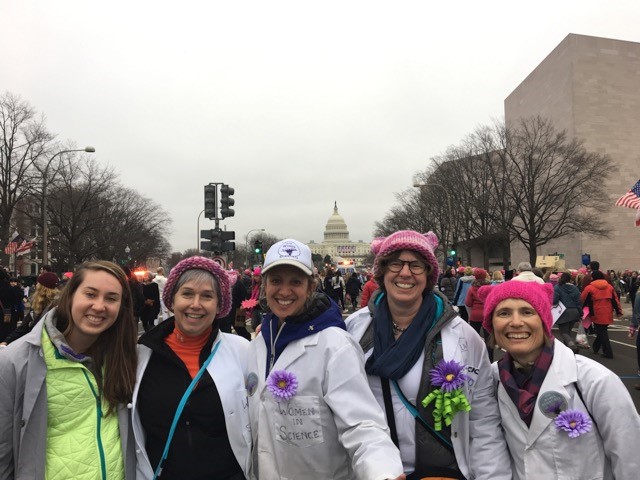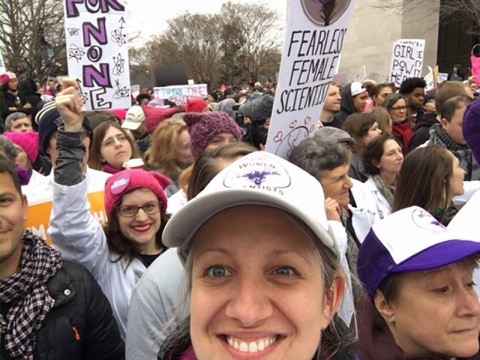27 February 2017
Finding Forward Momentum in Local Actions – Reflections from the Women’s March in DC
Posted by Shane Hanlon
By Christy Till. This is part 1 in a 3-part series in which a US scientist reflects on the women’s march, making sense of the current political landscape, and finding answers in local science communication activities.
Allies of women in science gather before the women’s march on January 21st, as part of the group from 500 Women Scientists that marched in DC and in sister cites around the world.
“Whatever you do may seem insignificant, but it is most important that you do it.” – Mahatma Gandhi
The daughter of anti-Vietnam protesters, I have always idolized the power of people showing up in the streets en masse to speak truth to power. So, after the election, I considered joining the Women’s March in DC as a first step forward amidst the chaos. A Facebook post to gauge interest in organizing a group to march in support of women in science ballooned overnight into hundreds of responses and so it was decided. I had signed the 500 Women Scientists Pledge after the election, and when I learned they were also planning a march group to voice the same values – a diverse workforce, data, peer-reviewed science, the reality of climate change – we joined forces and made plans for our group in DC and sister marches around the world.
When our group of over a hundred allies of women in science gathered on January 21st near the Air and Space Museum in DC, the enthusiasm from the crowd passing us by was unlike anything I ever experienced. Each of us had our own message scrawled in sharpie on our white lab coats: “A woman’s place is in the lab”, “This is what a scientist looks like”, “What do we want? Evidence-based claims! When do we want it? After peer review!”. My lab coat paid homage to the women who paved my path in science, and to those who will create the path of the future, as well as the names of many friends and colleagues who could not be there in person. Before we were overtaken by the crowd for the rally, we were cheered, interviewed, and asked for our picture time and time again. The palpable support and respect for scientists from anonymous strangers came as a surprise many of us. Those who never made it to our meeting spot on the Mall due to the size of the crowds reported the same reaction from their neighbors. In this crowd, science was a celebrity. The size of the protests around the world that day, the peacefulness of the march, the media coverage of our group, and the sense of being part of something larger than myself – were more than I had hoped for when I had written that Facebook post. But when I awoke the morning after the march, I was already asking, how do we channel this energy into constructive action going forward?

Women in Science from Arizona State University gather during the Women’s March on January 21st, from right to left, Dr. Heather Throop, Dr. Hilairy Hartnett, Dr. Christy Till, Dr. Linda Elkins-Tanton and Caroline Hanson.
–Christy Till is an Assistant Professor in the School of Earth & Space Exploration at Arizona State University who leads a multidisciplinary research program that studies the role of magma in the formation and evolution of planets. She previously served as Vice Chair of the Council of the American Geophysical Union (2012-2014).











 The Plainspoken Scientist is the science communication blog of AGU’s Sharing Science program. With this blog, we wish to showcase creative and effective science communication via multiple mediums and modes.
The Plainspoken Scientist is the science communication blog of AGU’s Sharing Science program. With this blog, we wish to showcase creative and effective science communication via multiple mediums and modes.